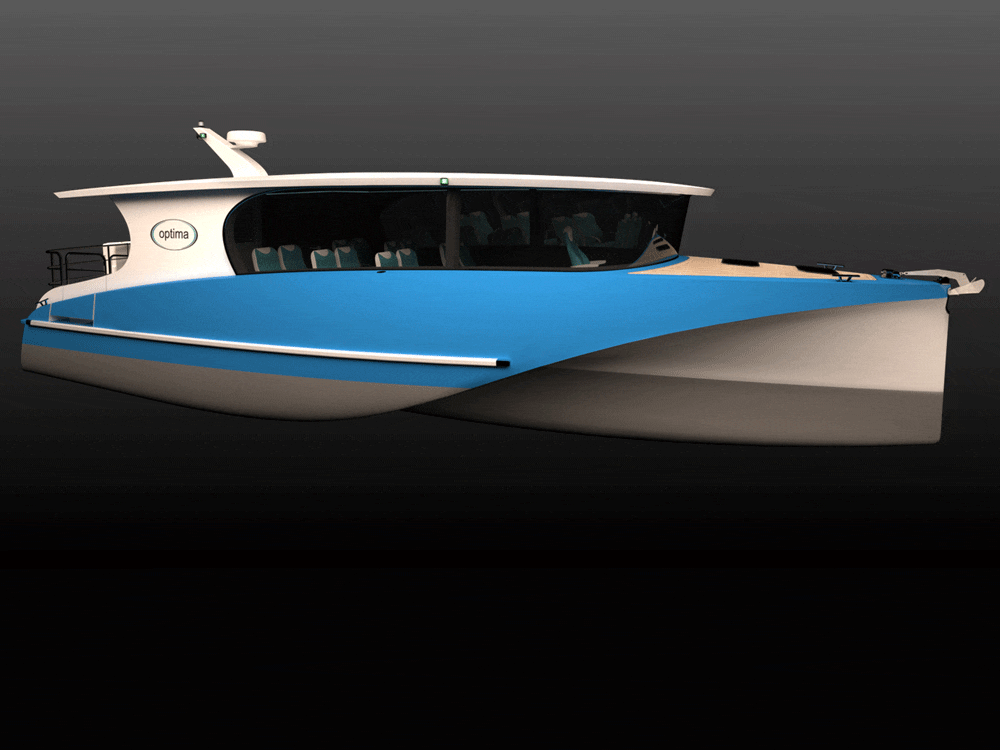A collaborative project spearheaded by Optima Electric Yachts – a company dedicated to producing 100% electric boats with energy-saving hullforms – and funded by the fourth round of the UK government’s Clean Maritime Demonstration Competition (CMDC4), aims to develop an electric vessel for urban riverine transport, as well as potential leisure and commercial marine applications.
David Kendall, Optima CEO and designer of the water taxi, tells Ship & Boat International: “There is potential interest in areas that have not previously utilised water transport, but which are keen to do so to provide more sustainable means of transport, relieve road congestion and promote tourism.” Considering the boat’s target markets, Kendall adds: “We are particularly interested in the Solent region…[and] see opportunities in areas such as the UAE and Saudi Arabia.”
Project partners include Seabird Technologies (developer of the E1 foiling electric race boat), propeller manufacturer Teignbridge Propellers and marine coatings firm Edwards & Renouf, among others. The 13m x 4.4m water taxi will feature a 1m draught and the capacity for 12 passengers and two crew members. “The vessel produces low wake, which is an additional benefit in urban areas for both shoreside erosion and for the benefit of other water users,” says Kendall.
Li-ion battery system
Although the propulsion system was still being determined at the time of going to press, Optima is aiming for a 100kW/400V, water-cooled lithium-ion battery system. This would grant the vessel a range of 50-100nm depending on speed, Kendall says, “with its wave piercing hull providing much greater comfort and safety compared to a conventional planing hull”. Photovoltaic panels will be installed on the roof, to cover some of the hotel electrical loads.
Kendall explains that the partners are keen to preserve energy where possible. One example, he says, is the cabin, which will be climate-controlled for passenger comfort. However, he highlights, this arrangement constitutes “a significant extra electrical demand, so we are taking measures to minimise this with insulation, reflective surfaces to reduce heat gain, and so on”. Overall, Kendall predicts that the craft will realise CO2 savings of approximately 660tonnes per year. “If small water taxis replace underutilised large ferries that are often running less than half-full, then the CO2 savings will be significantly greater,” he states.
Composite propeller
The project will also give Teignbridge an opportunity to test its new 7kg, 300mm-diameter, five-bladed composite propeller. Development of the propeller stems back to 2021, when Teignbridge partnered with the UK’s National Composites Centre. The two groups commenced a design feasibility study (funded by the first CMDC round) for the prop, incorporating CFD and finite element (FE) analysis software.
Saeed Javdani, design and development manager at Teignbridge, highlights various benefits in using composite propellers over their metallic counterparts. “The orientation and thickness of the fibres can be tailored to achieve the required mechanical properties – strength and stiffness – where they are most needed, but also allows flexibility to be designed into the propeller,” he says. As such, they can be manufactured thinner and lighter than steel propellers without compromising on performance, he adds.
“The lighter weight of the propeller means that smaller-diameter shafts can be utilised as the moment of inertia is reduced,” Javdani continues. “This puts less loading on the other parts of the driveline, which helps to increase the longevity of the whole propulsion system. The flexibility of the composite material can be specified during the design phase so that the loading on the propeller during use allows controllable blade deflection, meaning that cavitation inception is restrained.
“This creates a damping effect that yields lower vibration and substantial noise reduction compared to metallic propellers. The damping effect also helps reduce engine overload conditions which can be experienced during stormy weather and harsh acceleration, causing premature wear on equipment.”
The first of the water taxis should be ready for production in 2025, Optima’s Kendall predicts.






